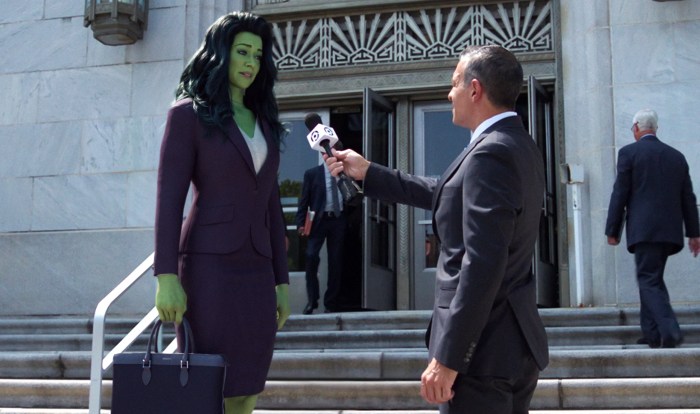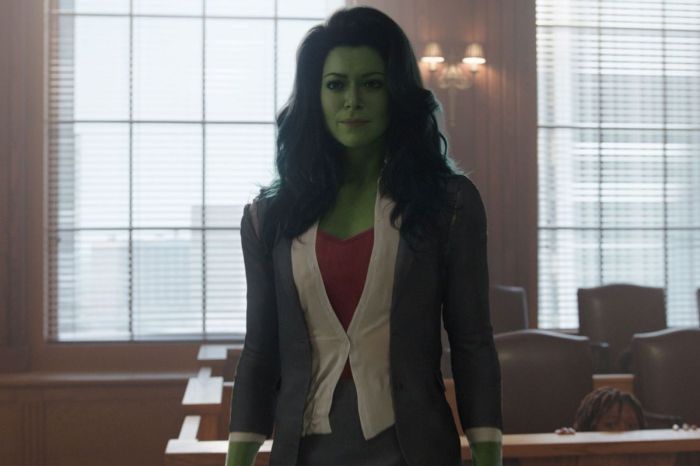She-Hulk: Attorney at Law presents a unique portrayal of a female superhero, challenging conventional representations of strength and beauty. This exploration delves into the multifaceted aspects of She-Hulk’s physical form, examining its impact on audience perception, the role of CGI in its creation, and the connection between her body and her extraordinary abilities. We will analyze her physique, costume design, and the broader messages conveyed regarding body positivity and female empowerment within the context of the show.
From the detailed musculature and proportions of her gamma-irradiated form to the subtle nuances of her body language, She-Hulk’s physical presence is a key element of her character. This analysis will dissect the visual effects employed to bring her to life, explore the challenges faced by the production team, and consider the societal implications of her portrayal in a landscape saturated with idealized images of female superheroes.
She-Hulk’s Physical Representation

She-Hulk’s physical form is a significant aspect of her character, representing both her immense power and her unique position as a female superhero navigating a predominantly male-dominated world. Her design and portrayal have evolved over time, reflecting changing cultural perceptions of female strength and body image.
She-Hulk’s body type is characterized by extreme muscularity and proportionally enhanced size compared to her human form, Jennifer Walters. Her physique is defined by large, well-defined muscles throughout her body, suggesting exceptional strength and power. Her proportions are exaggerated, with longer limbs and a broader torso than a typical human female. The overall effect is one of imposing strength and a commanding presence.
Comparison with Other Female Superheroes
She-Hulk’s physique contrasts significantly with other female superheroes. While some, like Wonder Woman, also possess superhuman strength and impressive musculature, She-Hulk’s build is generally more exaggerated and less conventionally “feminine.” Characters like Black Widow or Captain Marvel, while powerful, are depicted with more streamlined, less overtly muscular figures. This difference highlights She-Hulk’s unique visual identity and the deliberate choice to represent her power through a more overtly powerful and less conventionally attractive physique. This choice is often interpreted as a commentary on societal beauty standards and the representation of female strength.
Visual Representation of Strength
She-Hulk’s strength is visually communicated not only through her physique but also through her body language and posture. Her confident stance, often with her hands on her hips or arms crossed, projects an aura of power and control. She rarely displays vulnerability or fragility in her posture. Even in moments of relaxation, her body language subtly communicates her underlying strength and readiness for action. The way she moves, even small gestures, conveys a sense of power and control that reinforces her physical prowess.
She-Hulk’s Body Type Across Appearances
| Appearance | Musculature | Proportions | Overall Impression |
|---|---|---|---|
| Early Comic Book Appearances | Moderately muscular, more traditionally feminine proportions | Slightly exaggerated, but closer to human proportions | Powerful but still retaining a degree of conventional attractiveness |
| Modern Comic Book Appearances | Extremely muscular, highly defined | Significantly exaggerated, with longer limbs and broader shoulders | Imposing, powerful, and less conventionally attractive |
| She-Hulk (2022 TV Series) | Highly muscular, but with a more realistic and less exaggerated portrayal than in some comics | Exaggerated but less so than some comic book iterations; maintaining a more human-like appearance | Powerful and confident, while maintaining a sense of relatability |
| Animated Appearances (e.g., Avengers Assemble) | Variable, depending on the animation style, but generally more stylized and less realistically muscular than the live-action series | Variable, but often more exaggerated than live-action | Style-dependent; can range from powerful and imposing to more streamlined and less overtly muscular |
The Portrayal of Body Image

She-Hulk’s design, a powerful woman with a significantly larger physique than the average human female, presents a complex and multifaceted portrayal of body image within a superhero context. Her appearance challenges conventional beauty standards often presented in mainstream media, prompting diverse reactions and sparking important conversations about body positivity and female representation. The impact of this representation extends beyond simple aesthetics, influencing how audiences perceive female strength, power, and self-acceptance.
She-Hulk’s physique directly confronts the often-narrowly defined ideal of female beauty prevalent in popular culture. Unlike many female superheroes who adhere to a more conventionally attractive physique, She-Hulk’s muscular build openly rejects this standard. This departure from the norm serves as a powerful statement, potentially encouraging viewers to reconsider and broaden their understanding of what constitutes an attractive and powerful female form. The show’s writers and producers have explicitly stated their intent to depict a strong, confident woman who embraces her body, regardless of societal expectations. This intention, however, has not been universally received.
She-Hulk’s Body Type and Audience Perception
She-Hulk’s body type has elicited a range of responses from audiences. Some viewers have celebrated her representation as a positive step towards inclusivity and body positivity, highlighting the importance of showcasing diverse body types in popular media. These positive reactions often emphasize the character’s confidence and strength, associating her physical attributes with empowerment rather than solely with physical attractiveness. Conversely, negative reactions have focused on aspects deemed “unattractive” according to conventional beauty standards. Critics have expressed discomfort with her size, suggesting it deviates too far from the idealized female form often portrayed in popular media. These critiques, however, often overlook the deliberate choice to represent a strong and powerful woman who does not conform to traditional beauty norms.
Messages Conveyed Regarding Body Positivity and Female Empowerment
She-Hulk’s portrayal attempts to convey several messages related to body positivity and female empowerment. Her confidence and self-acceptance, despite not conforming to conventional beauty standards, directly challenge the pressure women often face to fit into specific body types. The show seeks to normalize diverse body shapes and sizes, suggesting that strength and attractiveness are not mutually exclusive and can exist independently of societal expectations. This messaging, however, is complex and may not resonate universally with all viewers. Some may interpret her body type as a deviation from conventional attractiveness, while others may see it as a bold statement of self-acceptance and empowerment.
Comparison with Societal Beauty Standards
She-Hulk’s physique stands in stark contrast to the often-unrealistic and unattainable beauty standards promoted by mainstream media. These standards typically emphasize thinness, a specific body shape, and often unattainable levels of physical perfection. She-Hulk’s muscular build actively challenges these norms, suggesting an alternative vision of female beauty that values strength, power, and self-acceptance over conformity to restrictive ideals. This direct challenge can be perceived as both empowering and potentially disruptive to those accustomed to the prevailing beauty standards. The contrast serves as a focal point for discussion around the pressures faced by women to conform to unrealistic body images.
Examples of Positive and Negative Reactions to She-Hulk’s Physical Portrayal
Positive reactions to She-Hulk’s portrayal frequently praise the show’s commitment to representing a strong and confident female character who embraces her body. These comments often highlight the importance of diverse representation in media and celebrate the show’s attempt to challenge traditional beauty standards. Negative reactions, conversely, frequently criticize her appearance as being “too large” or “unattractive,” reflecting a continued adherence to narrow and often unrealistic beauty ideals. These critiques often ignore the intentional subversion of these standards and the message of self-acceptance the character embodies. The existence of both positive and negative reactions underscores the complex and multifaceted nature of the show’s attempt to redefine female representation in superhero media.
The Role of CGI and Visual Effects
She-Hulk: Attorney at Law’s success hinges significantly on the seamless integration of CGI and visual effects, particularly in rendering Tatiana Maslany’s transformation into the titular She-Hulk. The show’s creators faced the considerable challenge of creating a believable and appealing CGI character that wouldn’t detract from the narrative or appear jarring to viewers. This involved a sophisticated blend of performance capture, digital modeling, and rendering techniques.
The creation of She-Hulk’s appearance involved a multi-stage process. First, Maslany performed the role in a motion capture suit, providing the basis for She-Hulk’s movements and expressions. This performance data was then used to create a digital model of She-Hulk, meticulously sculpted and textured to match Maslany’s likeness while incorporating the character’s distinctive features – increased height, muscular physique, and green skin. Subsequently, advanced rendering techniques were employed to create realistic lighting, shadows, and skin textures, ensuring a believable integration of the CGI character within the live-action environment. The process aimed for photorealism, minimizing the “uncanny valley” effect often associated with CGI characters.
She-Hulk’s CGI Design Challenges and Considerations
Designing a believable and appealing CGI character presents numerous challenges. Maintaining consistency in She-Hulk’s appearance across different lighting conditions and camera angles was paramount. The team had to ensure that her skin texture, muscle definition, and overall proportions remained consistent, avoiding inconsistencies that could break the illusion. Furthermore, the CGI needed to complement Maslany’s performance, subtly enhancing her movements and expressions without overshadowing her acting. The emotional range needed to be accurately translated into the CGI character, ensuring She-Hulk’s expressiveness wasn’t diminished. Finally, the visual effects had to integrate seamlessly with the live-action elements of the show, ensuring a cohesive and believable overall aesthetic. The goal was not to create a hyper-realistic, overly detailed model, but rather one that complemented the overall tone and style of the show.
Evolution of She-Hulk’s Visual Representation
While the fundamental design of She-Hulk remained consistent throughout the series, subtle refinements were made over the course of production. Early episodes may have shown slight differences in skin texture or muscle definition compared to later episodes, reflecting the iterative nature of CGI development. Feedback from viewers and internal reviews likely informed these adjustments, leading to a progressively more polished and refined visual representation. This process is typical in CGI-heavy productions, where continuous refinement and improvement are essential for achieving the desired level of realism and visual appeal. The creators aimed for a believable evolution, not a drastic alteration of the character’s design.
Behind-the-Scenes: CGI Process for a Specific Scene
Let’s consider a scene where She-Hulk is involved in a physical altercation, perhaps a courtroom brawl. First, Maslany performed the scene wearing a motion capture suit, meticulously executing the fight choreography. This data provided the foundation for the CGI model’s movements, capturing the nuance of her punches, blocks, and expressions. The animation team then used this data to animate the She-Hulk model, carefully adjusting the movements to reflect her superhuman strength and agility. Next, the lighting and shading were carefully adjusted to ensure consistency with the surrounding environment, including the reflection of light on her skin and the interaction of her muscles during movement. Finally, the CGI She-Hulk was composited into the live-action footage, requiring meticulous attention to detail to ensure seamless integration and believable interaction with the other actors and the set. The final step involved color correction and final rendering, refining the overall look and feel to align with the show’s established visual style. This complex process involved numerous iterations and revisions, ensuring the scene’s visual fidelity and consistency with the character’s established appearance throughout the series.
She-Hulk’s Body and Her Abilities
She-Hulk’s enhanced physical attributes are intrinsically linked to her gamma-irradiated physiology, granting her superhuman strength, speed, durability, and other abilities. The transformation from Jennifer Walters into She-Hulk is not merely a cosmetic change; it represents a fundamental alteration in her physical structure and capabilities, profoundly impacting her actions and interactions with her environment.
She-Hulk’s body type is a significant factor in her abilities. Her increased size and musculature provide her with immense strength and resilience, allowing her to perform feats far beyond human capacity. However, this same bulk can also present challenges. Her increased mass, for example, might affect her agility and speed compared to smaller, more nimble opponents. The sheer power she possesses also necessitates careful control to avoid collateral damage.
She-Hulk’s Physical Capabilities Compared to Jennifer Walters
The differences between She-Hulk and Jennifer Walters are stark. Jennifer possesses average human strength and agility. She-Hulk, on the other hand, possesses superhuman strength, enabling her to lift incredible weights and withstand immense force. Her speed and reflexes are also dramatically enhanced, allowing her to react to and evade threats that would overwhelm Jennifer. She-Hulk’s skin is incredibly durable, protecting her from significant injuries that would incapacitate Jennifer. This enhanced durability also extends to her stamina; She-Hulk can endure prolonged physical exertion far beyond Jennifer’s capabilities. In essence, She-Hulk’s physical capabilities represent a massive amplification of Jennifer’s human potential.
Instances Where She-Hulk’s Body is Crucial to Her Success or Failure
The following examples illustrate how She-Hulk’s physical form is both a powerful asset and a potential liability:
- Success: In a courtroom confrontation, She-Hulk’s imposing stature can intimidate witnesses or opponents, subtly influencing the proceedings in her favor. Her strength allows her to physically restrain dangerous individuals, ensuring their safety and the security of the court.
- Success: During a high-speed chase, She-Hulk’s enhanced speed and agility allow her to apprehend criminals and keep pace with high-performance vehicles, something Jennifer would be unable to accomplish.
- Success: When facing a powerful physical threat, She-Hulk’s superhuman strength and durability are essential for her survival and the protection of others. She can withstand blows that would be fatal to a normal human.
- Failure: She-Hulk’s increased size can make her a less agile combatant in confined spaces, hindering her ability to maneuver effectively. Her large frame can also be a target for attacks that exploit her limited maneuverability.
- Failure: Despite her incredible strength, She-Hulk’s immense weight can limit her ability to perform certain acrobatic maneuvers or navigate delicate situations that require precision and finesse.
Final Review

Ultimately, She-Hulk’s body in “Attorney at Law” transcends mere aesthetics. It serves as a powerful symbol of strength, resilience, and self-acceptance, challenging traditional beauty standards and promoting a more inclusive vision of female empowerment. The show’s careful crafting of her CGI appearance, combined with a nuanced narrative exploring body image, offers a compelling case study in the representation of female superheroes in modern media. The lasting impact of this portrayal will undoubtedly continue to spark conversation and inspire further discussion within the realms of both superhero fiction and broader societal perceptions of female strength.
General Inquiries
What are the key differences between She-Hulk’s body and other female superheroes?
She-Hulk’s physique is notably more muscular and less conventionally “idealized” than many other female superheroes. She embraces her strength and power visibly, contrasting with more slender or conventionally attractive depictions.
How does She-Hulk’s costume contribute to her overall image?
Her costume is designed to be both functional and stylish, reflecting her professional life as a lawyer while accommodating her powerful physique. It’s less overtly sexualized compared to some other superhero costumes, emphasizing strength and practicality.
Were there any significant controversies surrounding She-Hulk’s body portrayal?
Yes, some viewers expressed negative reactions to her body type, citing concerns about unrealistic proportions or deviating from traditional beauty standards. However, many others praised the show for its positive representation of body positivity and female empowerment.
How does She-Hulk’s human form (Jennifer Walters) differ from her She-Hulk form in terms of abilities?
Jennifer Walters possesses enhanced strength, speed, and durability as She-Hulk, far exceeding her human capabilities. Her healing factor is also significantly improved. However, she retains her intellect and legal expertise in both forms.